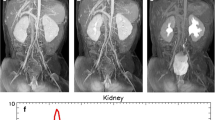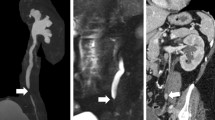Abstract
Dynamic magnetic resonance urography (MRU) scans acquired in conjunction with an injection of a contrast agent can be used to estimate a number of parameters that reflect renal function. This article discusses the methodologies and assumptions used in the estimation of these parameters, with special attention to the problem of deriving the concentration of the contrast agent from the change in the MR signal. The estimates of split renal function derived from MRU are in good agreement with those obtained using nuclear medicine studies. The time-intensity curves show subtle differences from those measured using nuclear medicine but still allow the transit of the contrast agent through the kidney to be assessed. Quantitative estimates of renal function (GFR) can be derived from MRU but have yet to be validated in a pediatric population.







Similar content being viewed by others
References
Gates GF (1992) Glomerular filtration rate: estimation from fractional renal accumulation of Tc-99m-DTPA (stannous). AJR 138:565–570
Itoh K (2003) Comparison of methods for determination of glomerular filtration rate: Tc-99m-DTPA renography, predicted creatinine clearance method and plasma sample method. Ann Nucl Med 17:561–565
Brochner-Mortensen J (1983) The extracellular fluid volume in normal man determined as the distribution volume of [51Cr] EDTA. Scand J Clin Lab Invest 42(3):261–264
Blaufox MD, Aurell M, Bubeck B et al (1996) Report of the Radionuclides in Nephrourology Committee on renal clearance. J Nucl Med 37:1883–1890
Lonergan GJ, Pennington DJ, Morrison JC et al (1998) Childhood pyelonephritis: comparison of gadolinium-enhanced MR imaging and renal cortical scintigraphy for diagnosis. Radiology 207(2):377–384
Choyke PL, Austin HA, Frank JA et al (1992) Hydrated clearance of gadolinium DTPA as a measurement of glomerular filtration rate. Kidney Int 41:1595–1598
Donahue KM, Weisskoff RM, Burstein D et al (1997) Water diffusion and exchange as they influence contrast enhancement. J Magn Reson Imaging 7(1):102–120
Shuter B, Tofts PS, Wang SC et al (1996) The relaxivity of Gd-EOB-DTPA and Gd-DTPA in liver and kidney of the Wistar rat. Magn Reson Imaging 14(3):243–253
Jones RA, Ries M, Moonen CTW et al (2002) Imaging the changes in renal T1 induced by the inhalation of pure oxygen: a feasibility study. Magn Reson Med 47:728–735
Gowland PA, Stevenson VL (2003) T1: the longitudinal relaxation time. In: Tofts P (ed) Quantitative MRI of the brain. Wiley, Chichester
Graumann R, Barfuss H, Fischer H et al (1987) TOMROP: a sequence for determining the longitudinal relaxation time in magnetic resonance tomography. Electromedica 55:67–72
Lee VS, Rusinek H, Noz ME et al (2003) Dynamic three-dimensional MR renography for the measurement of single kidney function: initial experience. Radiology 227:289–294
Grattan-Smith JD, Perez-Bayfield MR, Jones RA et al (2003) MR imaging of kidneys: functional evaluation using F-15 perfusion imaging. Pediatr Radiol 33:293–304
Ergen FB, Hussain HK, Carlos RC et al (2007) 3-D excretory MR urography: improved image quality with intravenous saline and diuretic administration. J Magn Reson Imaging 25:783–789
Buckley DL, Shurrab AE, Cheung CM et al (2006) Measurement of single kidney function using dynamic contrast-enhanced MRI: comparison of two models in human subjects. J Magn Reson Imaging 24:1117–1123
Brookes JA, Redpath TW, Gilbert FJ et al (1996) Measurement of spin-lattice relaxation times with FLASH for dynamic MRI of the breast. Br J Radiol 69:206–214
Cron GO, Santyr G, Kelcz F (1999) Accurate and rapid quantitative dynamic contrast-enhanced breast MR imaging using a spoiled gradient recalled echoes and bookend T1 measurements. Magn Reson Med 42:746–753
Parker GJ, Barker GJ, Tofts P (2001) Accurate multislice gradient echo T(1) measurement in the presence of non-ideal RF pulse shape and RF field nonuniformity. Magn Reson Med 45:838–845
Reddick WE, Ogg RJ, Steen RG et al (1996) Statistical error mapping for reliable quantitative T1 imaging. J Magn Reson Imaging 6(1):244–249
Mørkenborg J, Pedersen M, Jensen FT et al (2003) Quantitative assessment of Gd-DTPA contrast agent from signal enhancement: an in-vitro study. Magn Reson Imaging 21:637–643
Rusinek H, Lee V, Johnson G (2001) Optimal dose of Gd-DTPA in dynamic MR studies. Magn Reson Med 46:312–316
Bokacheva L, Rusinek H, Chen Q et al (2007) Quantitative determination of Gd-DTPA concentration in T1-weighted renal perfusion studies. Magn Reson Med 57:1012–1018
Rodriguez LV, Spielman D, Herfkens RJ et al (2001) Magnetic resonance imaging for the evaluation of hydronephrosis, reflux and renal scarring in children. J Urol 166(3):1023–1027
Hackstein N, Heckrodt J, Rau WS (2003) Measurement of single kidney glomerular filtration rate using a contrast enhanced dynamic gradient echo sequence and the Rutland Patlak plot technique. J Magn Reson Imaging 18:714–725
Jones RA, Easley K, Little SB et al (2005) Dynamic contrast-enhanced MR urography in the evaluation of pediatric hydronephrosis: part 1 functional assessment. AJR 185:1598–1607
Bland JM, Altman DG (1999) Measuring agreement in method comparison studies. Stat Methods Med Res 8:135–160
Taylor J, Summers PE, Keevil SF et al (1997) Magnetic resonance renography: optimisation of pulse sequence parameters and Gd-DTPA dose, and comparison with radionuclide renography. Magn Reson Imaging 15:637–649
Teh HS, Ang ES, Wong WC et al (2003) MR renography using a dynamic gradient-echo sequence and low-dose gadopentetate dimeglumine as an alternative to radionuclide renography. AJR 181:441–450
Perez-Brayfield MR, Kirsch AJ, Jones RA et al (2003) A prospective study comparing ultrasound, nuclear scintigraphy and dynamic contrast-enhanced magnetic resonance imaging in the evaluation of hydronephrosis. J Urol 170:1330–1334
Heuer R, Sommer G, Shortliffe LD (2003) Evaluation of renal growth by magnetic resonance imaging and computerized tomography volumes. J Urol 170:1659–1663, discussion 1663
Van den Dool SW, Wasser MN, de Fijter JW et al (2005) Functional renal volume: quantitative analysis at gadolinium-enhanced MR angiography – feasibility study in healthy potential kidney donors. Radiology 236:189–195
Rohrschneider WK, Becker K, Hoffend J et al (2000) Combined static and dynamic MR urography for the simultaneous evaluation of morphology and function in urinary tract obstruction. I Evaluation of the normal status in an animal model. Pediatr Radiol 30(8):511–522
Hackstein N, Kooijman H, Tomaselli S et al (2005) Glomerular filtration rate measured using the Patlak plot technique and contrast-enhanced dynamic MRI with different amounts of gadolinium-DTPA. J Magn Reson Imaging 22:406–414
Rutland MD (1979) A single-injection technique for subtraction of blood background in 131I-hippuran renograms. Br J Radiol 52:134–137
Patlak CS, Blasberg RG, Fenstermacher JD (1983) Graphical evaluation of blood-to-brain transfer constants from multiple time uptake data. J Cereb Blood Flow Metab 3:1–7
Peters AM (1994) Graphical analysis of dynamic data: the Patlak-Rutland plot. Nucl Med Commun 15:669–672
Sharkey I, Boddy AV, Wallace H et al (2001) Body surface area estimation in children using weight alone: application in paediatric oncology. Br J Cancer 85(1):23–28
Wahl EF, Lahdes-Vasama TT, Churchill BM (2003) Estimation of glomerular filtration rate and bladder capacity: the effect of maturation, aging, gender and size. BJU Int 91(3):255–262
Author information
Authors and Affiliations
Corresponding author
Additional information
Dr. Jones discloses that the content of this article will describe use of a medical device or pharmaceutical that is “off-label,” i.e. a use not described on the product’s label.
Rights and permissions
About this article
Cite this article
Jones, R.A., Schmotzer, B., Little, S.B. et al. MRU post-processing. Pediatr Radiol 38 (Suppl 1), 18–27 (2008). https://doi.org/10.1007/s00247-007-0616-9
Received:
Accepted:
Published:
Issue Date:
DOI: https://doi.org/10.1007/s00247-007-0616-9




